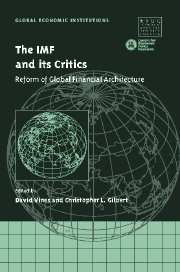Book contents
- Frontmatter
- Contents
- List of figures
- List of tables
- List of contributors
- Acknowledgements
- Introduction
- 1 The IMF and international financial architecture: solvency and liquidity
- 2 Progress towards greater international financial stability
- 3 International coordination of macroeconomic policies: still alive in the new millennium?
- 4 The Report of the International Financial Institution Advisory Commission: comments on the critics
- 5 Reforming the global financial architecture: just tinkering around the edges?
- 6 The IMF and capital account liberalisation
- 7 How should the IMF view capital controls?
- 8 The resolution of international financial crises: an alternative framework
- 9 Whose programme is it? Policy ownership and conditional lending
- 10 The IMF and East Asia: a changing regional financial architecture
- 11 The role of the IMF in developing countries
- 12 Argentina and the Fund: anatomy of a policy failure
- 13 Countries in payments' difficulties: what can the IMF do?
- 14 Accountability, governance and the reform of the IMF
- 15 The IMF at the start of the twenty-first century: what has been learned? On which values can we establish a humanised globalisation?
- Index
- References
5 - Reforming the global financial architecture: just tinkering around the edges?
Published online by Cambridge University Press: 04 December 2009
- Frontmatter
- Contents
- List of figures
- List of tables
- List of contributors
- Acknowledgements
- Introduction
- 1 The IMF and international financial architecture: solvency and liquidity
- 2 Progress towards greater international financial stability
- 3 International coordination of macroeconomic policies: still alive in the new millennium?
- 4 The Report of the International Financial Institution Advisory Commission: comments on the critics
- 5 Reforming the global financial architecture: just tinkering around the edges?
- 6 The IMF and capital account liberalisation
- 7 How should the IMF view capital controls?
- 8 The resolution of international financial crises: an alternative framework
- 9 Whose programme is it? Policy ownership and conditional lending
- 10 The IMF and East Asia: a changing regional financial architecture
- 11 The role of the IMF in developing countries
- 12 Argentina and the Fund: anatomy of a policy failure
- 13 Countries in payments' difficulties: what can the IMF do?
- 14 Accountability, governance and the reform of the IMF
- 15 The IMF at the start of the twenty-first century: what has been learned? On which values can we establish a humanised globalisation?
- Index
- References
Summary
Introduction
The 1990s was a tumultuous decade for the international financial system, especially for emerging-market countries. Capital flows to those countries increased dramatically in the first few years of the decade. But from 1994 to 1999, the world economy was shaken by a series of financial crises in Mexico, East Asia, Russia and in a number of other emerging markets. These crises caused major recessions in the affected countries. But they were a wake-up call to policy-makers that the existing international financial architecture must be reformed.
The surge in capital inflows to emerging-market economies during the first half of the 1990s was driven by high rates of investment relative to saving in these countries and associated high expected returns, financial liberalisation and innovation and lower transactions costs. Simultaneously, investors in the industrial countries increased their supply of financial capital in the belief that international diversification, the explicit or implicit guarantees offered by the governments of developing countries and the prospect of international bailouts if things went wrong had mitigated the risks of increased exposures to emerging markets. In retrospect, it is evident that many of the same structural changes that facilitated large capital inflows to these economies also exacerbated outflows when expectations shifted. In such circumstances, pegged exchange rate regimes collapsed and weak banking systems imploded. The international financial architecture failed to forestall these crises or limit contagion. As a result, economic expansions in many emerging-market countries were suddenly thrown into reverse.
- Type
- Chapter
- Information
- The IMF and its CriticsReform of Global Financial Architecture, pp. 124 - 155Publisher: Cambridge University PressPrint publication year: 2004



